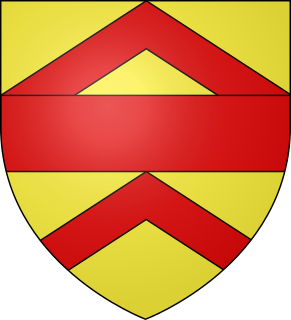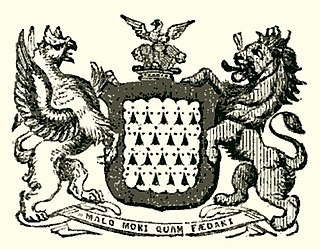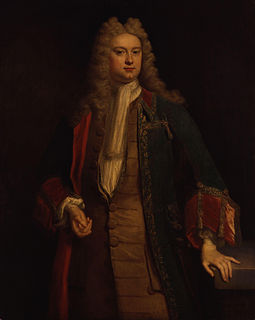
Earl of Longford is a title that has been created twice in the Peerage of Ireland.

Baron FitzWalter is an ancient title in the Peerage of England. It was created on 24 June 1295 for Robert FitzWalter. The title was created by writ, which means that it can descend through both male and female lines. His great-grandson, the fourth Baron, was an Admiral of the Fleet. The fourth baron's grandson, the seventh Baron, was succeeded by his daughter and only child, Elizabeth. She was the wife of John Radcliffe. Their son, the ninth Baron, was attainted for treason in 1495 with his title forfeited. However, his son Robert Radcliffe obtained a reversal of the attainder by Act of Parliament in 1509 and later served as Lord Lieutenant of Lancashire. He was created Viscount FitzWalter in 1525 and Earl of Sussex in 1529. His grandson, the third Earl, was summoned to the House of Lords through a writ of acceleration in 1553 in his father's junior title of Baron FitzWalter. Lord Sussex later served as Lord Deputy of Ireland. He was succeeded by his younger brother, the fourth Earl. He had earlier represented Maldon, Hampshire and Portsmouth in the House of Commons and also served as Lord Lieutenant of Hampshire. When he died the titles passed to his only child, the fifth Earl. He was Lord Lieutenant of Essex.

Baron Willoughby de Eresby is a title in the Peerage of England. It was created in 1313 for Robert de Willoughby. Since 1983, the title has been held by Jane Heathcote-Drummond-Willoughby, 28th Baroness Willoughby de Eresby.

Earl of Chichester is a title that has been created three times in British history. The current title was created in 1801 for Thomas Pelham, 2nd Baron Pelham of Stanmer in the Peerage of the United Kingdom.

Earl of Wilton, of Wilton House in the County of Wiltshire, is a title in the Peerage of the United Kingdom. It was created in 1801 for Thomas Egerton, 1st Baron Grey de Wilton along with the subsidiary title of Viscount Grey de Wilton, also in the Peerage of the United Kingdom. Both titles were created with remainder to the second and all younger sons successively of his daughter Lady Eleanor, wife of Robert Grosvenor, 1st Marquess of Westminster.

Earl of Roden is a title in the Peerage of Ireland. It was created in 1771 for Robert Jocelyn, 2nd Viscount Jocelyn. This branch of the Jocelyn family descends from the 1st Viscount, prominent Irish lawyer and politician Robert Jocelyn, the son of Thomas Jocelyn, third son of Sir Robert Jocelyn, 1st Baronet, of Hyde Hall. He notably served as Lord Chancellor of Ireland from 1739 to 1756. In 1743 he was raised to the Peerage of Ireland as Baron Newport, of Newport, and in 1755 he was further honoured when he was made Viscount Jocelyn, also in the Peerage of Ireland. He was succeeded by his son, the second Viscount. He represented Old Leighlin in the Irish House of Commons and served as Auditor-General of Ireland. In 1770 he also succeeded his first cousin once removed as fifth Baronet of Hyde Hall. In 1771 he was created Earl of Roden, of High Roding in the County of Tipperary, in the Peerage of Ireland. Lord Roden married Lady Anne Hamilton, daughter of James Hamilton, 1st Earl of Clanbrassil and sister of James Hamilton, 2nd Earl of Clanbrassil, a title which became extinct in 1798.

Earl of Harrowby, in the County of Lincoln, is a title in the Peerage of the United Kingdom. It was created in 1809 for the prominent politician and former Foreign Secretary, Dudley Ryder, 2nd Baron Harrowby. He was made Viscount Sandon, of Sandon in the County of Stafford, at the same time, which title is used as a courtesy title by the heir apparent to the earldom. His son, the second Earl, held office under Lord Palmerston as Chancellor of the Duchy of Lancaster and Lord Privy Seal. He was succeeded by his eldest son, the third Earl. He was a Conservative politician and notably served as President of the Board of Trade from 1878 to 1880.

Earl of Verulam is a title in the Peerage of the United Kingdom. It was created in 1815 for James Grimston, 4th Viscount Grimston. He was made Viscount Grimston at the same time. Verulam had previously represented St Albans in the House of Commons. In 1808 he had also succeeded his maternal cousin as tenth Lord Forrester. He was succeeded by his son, the second Earl. He was a Tory politician and held minor office in the first two governments of the Earl of Derby. His son, the third Earl, represented St Albans in Parliament as a Conservative. His grandson, the sixth Earl was nominated to the traditionally safe seat of St Albans for the party. As of 2017 the titles are held by his son, the seventh Earl, who succeeded in 1973.

Baron Manners, of Foston in the County of Lincoln, is a title in the Peerage of the United Kingdom. It was created in 1807 for the lawyer and politician Sir Thomas Manners-Sutton. He served as Solicitor-General from 1802 to 1805 and as Lord Chancellor of Ireland from 1807 to 1827. Manners-Sutton was the fifth son of Lord George Manners-Sutton, third son of John Manners, 3rd Duke of Rutland. His elder brother Charles Manners-Sutton was Archbishop of Canterbury from 1805 to 1828 and the father of Charles Manners-Sutton, 1st Viscount Canterbury, Speaker of the House of Commons from 1817 to 1834. The first Baron's great-grandson, the fourth Baron, assumed the surname of Manners only. As of 2010 the title is held by the latter's grandson, the sixth Baron, who succeeded his father in 2008. As a descendant of the third Duke of Rutland he is also in remainder to this peerage and its subsidiary titles.
Baron O'Neill, of Shane's Castle in the County of Antrim, is a title in the Peerage of the United Kingdom. It was created in 1868 for the musical composer The Reverend William O'Neill. Born William Chichester, he succeeded to the estates of his cousin John Bruce Richard O'Neill, 3rd Viscount O'Neill, in 1855 and assumed by Royal licence the surname of O'Neill in lieu of Chichester in order to inherit the lands of his cousin, despite not being descended in the male line from an O'Neill. The Chichesters trace their lineage to the name O'Neill through Mary Chichester, daughter of Henry O'Neill of Shane's Castle. Lord O'Neill was the patrilineal great-great-great-grandson of John Chichester, younger brother of Arthur Chichester, 2nd Earl of Donegall. The latter two were both nephews of Arthur Chichester, 1st Earl of Donegall, and grandsons of Edward Chichester, 1st Viscount Chichester. Lord O'Neill was succeeded by his eldest son, the second Baron. He sat as a Conservative Member of Parliament for Antrim.

Baron Trimlestown, of Trimlestown in County Meath, is a title in the Peerage of Ireland.
The Comptroller of the Household is an ancient position in the British royal household, nominally the second-ranking member of the Lord Steward's department after the Treasurer of the Household. The Comptroller was an ex officio member of the Board of Green Cloth, until that body was abolished in the reform of the local government licensing in 2004. In recent times, a senior government whip has invariably occupied the office. On state occasions the Comptroller carries a white staff of office, as often seen in portraits.

Horatio Walpole, 1st Baron Walpole of Wolterton,, English diplomatist, was a son of Robert Walpole of Houghton, Norfolk, and a younger brother of the Prime Minister of Great Britain Sir Robert Walpole.
This is a list of people who have served as Lord Lieutenant of Essex. Since 1688, all the Lord Lieutenants have also been Custos Rotulorum of Essex.

Baron Hylton is a title that has been created twice, once in the Peerage of England and once in the Peerage of the United Kingdom. The first creation came in the Peerage of England 1295 when Robert Hylton was summoned to the Model Parliament as Lord Hylton by writ. His son, Alexander, was called to Parliament in 1332 and 1335, but no further summons were sent for his descendants. Therefore, the title has only been held de jure after the death of the second baron. Indeed, the last baron was Member of Parliament for Carlisle after "inheriting" the title, due to this anomaly. Despite this, the creation is deemed to have fallen into abeyance on the death of the eighteenth baron without male heirs in 1746.
This is a list of people who have served as Lord-Lieutenant of Radnorshire. After 1715, all Lord Lieutenants were also Custos Rotulorum of Radnorshire. The office was abolished on 31 March 1974, being replaced by the Lord Lieutenant of Powys, with Deputy Lieutenants for Radnorshire.
Baron Gwydyr, in the County of Carnarvon, was a title in the Peerage of Great Britain. It was created on 16 June 1796 for Sir Peter Burrell, 2nd Baronet, who had earlier represented Boston and Haslemere in the House of Commons. The Burrell Baronetcy, of West Grinstead Park in the County of Surrey, had been created in the Baronetage of Great Britain on 5 July 1766 for his great-uncle Merrik Burrell, with remainder to the latter's nephew Peter Burrell. Merrik Burrell had previously represented Marlow, Grampound, Haslemere and Great Bedwyn in Parliament. Lord Gwydyr married Priscilla Bertie, 21st Baroness Willoughby de Eresby, herself a descendant of the Aberffraw legacy through her grandmother Mary Wynn. They were both succeeded by their eldest son, Peter Drummond-Burrell, 22nd Baron Willoughby de Eresby. On the death in 1865 of his son, the two titles separated. The Barony of Willoughby de Eresby fell into abeyance between the late Baron's sisters while the baronetcy and barony of Gwydyr were inherited by his cousin, the fourth Baron. He was the son of the Honourable Lindsey Merrik Peter Burrell, younger son of the first Baron. The baronetcy and barony became extinct on the death of his son, the fifth Baron, on 13 February 1915.
The de Montesquiou family is a very old French noble family from Gascony. Its motto is Deo duce et ferro comite.
Robert Smith, 1st Baron Carrington, was a British banker and politician who sat in the House of Commons from 1779 to 1797 when he was raised to the peerage.

Francis Raymond Evershed, 1st Baron Evershed, PC was British judge who served as Master of the Rolls, and subsequently became a Law Lord.








